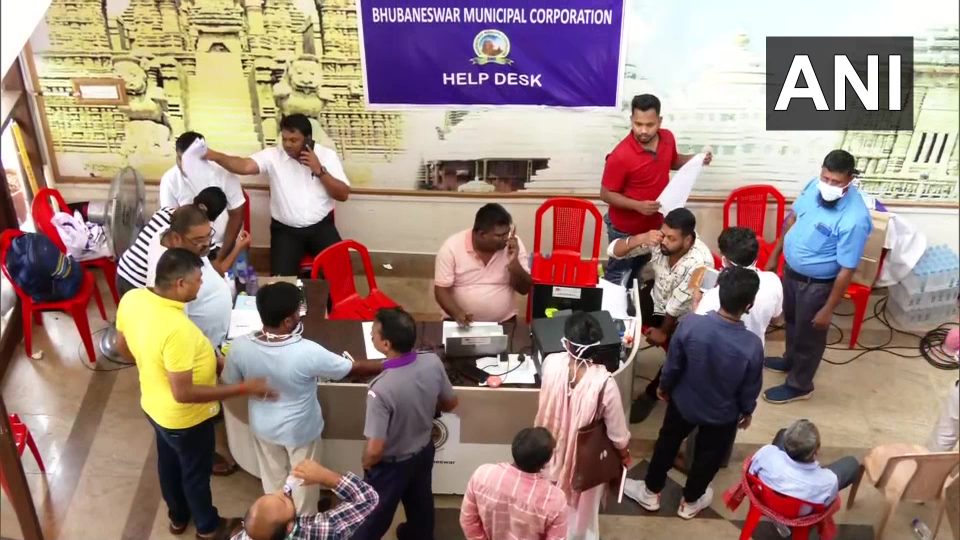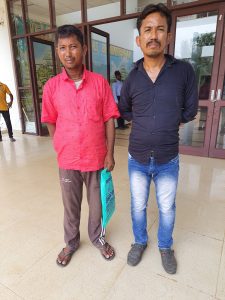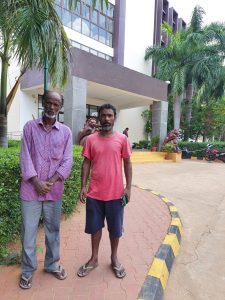
Odisha train tragedy: Losing a son, and then losing his body

Ramakanta Ray, 47, is in a hurry. Handing out some documents to his younger brother Bhabani, he asks him to get photocopies done in a flash. “We have to travel a long distance. We wish to cover at least 200 km before evening,” said Ramakanta, who arrived in the morning at Bhubaneswar’s All India Institute of Medical Sciences (AIIMS).
In just one month, this is the third time he has come from his village Kunail in West Bengal’s Dakshin Dinajpur district. Apart from Odisha and the bordering districts of Jharkhand and Chhattisgarh, hundreds of patients from West Bengal throng this medical facility on a regular basis.
Opinion: Newfangled trains need advanced maintenance; is Railways listening?
However, Ramakanta’s trips have been for a different reason: to carry home the body of his eldest son Suman, 21, a casualty of the grisly, June 2 Odisha train tragedy.

“I have received two calls from AIIMS, one yesterday afternoon and the other came this morning as we were nearing Cuttack,” says Ramakanta, a father of two sons, which included Suman, and a daughter.
According to him, Suman was on board the Coromandel Express to Chennai, where he worked as a mechanic.
Grisly tragedy
Considered the worst rail tragedy of the last three decades, the horrific accident involving the Shalimar-Chennai Coromandel Express, the Yashwantpur-Howrah Express and a stationary freight train at Bahanaga Bazar station near Balasore town cost 293 lives. Many victims were in the prime of their youth.
While 287 passengers died on the spot, six more succumbed to injuries subsequently. A total of 205 of the over 1,000 injured sustained serious injuries. Even a month later, some of them continue to be in the wards and ICUs of the SCB Medical College and Hospital, Cuttack.
Also read: A month later, Odisha train accident victims’ kin still wait for bodies
Post identification and verification, 211 bodies have been handed over to the families of the victims at Balasore. However, 81 bodies — charred and mutilated beyond recognition —couldn’t be identified, and had been stored in a refrigerated container at AIIMS.
Reportedly, around 40 passengers were believed to have died due to electrocution. As it was not possible to recognise the bodies from the photographs provided by the families, the Indian Railways and the Odisha government decided to go for DNA profiling.
DNA profiling
This is being done to prevent anomalies in identification as a few bodies had multiple claimants. Samples drawn from 84 persons had been sent to the Central Forensic Science Laboratory (CFSL), New Delhi. The claimants were told they would be contacted once the DNA reports arrived.
“DNA profiling is a cumbersome exercise and involves layers of scientific processes. The team of experts study each available data and sample minutely to arrive at a fool proof result,” says a senior police officer, who has handled many cases which required DNA profiling, and also attended workshops on the subject.
In the first phase, AIIMS has received crossmatch analysis of 29 of the 81 bodies. The Railway Police, in coordination with the CBI, the Railways and AIIMS officials, look after the process of handing out the bodies to their respective relatives after verification of documents and other mandatory formalities.
“As of today (July 3), 23 bodies have been returned. We expect the rest will be handed over in a few days,” an AIIMS official tells The Federal.
The victims’ relatives receive compensation (cheques) of ₹10 lakh as announced by the Railways. For this, the bodies need to be handed over.
Ramakanta’s travails
The Bhubaneswar Municipal Corporation (BMC) has made arrangements for ambulances and hearses to transport the bodies. As requested by the families, two bodies were cremated at a local crematorium.
However, Ramakanta has no such plans. He left home with a hired Bolero to carry his dead son. The cost of travel: ₹30,000.
Soon, Ramakanta’s nephew Pradyot tells his uncle that he has already fed the driver of the Bolero at a nearby roadside dhaba. Though he tries to wear a relaxed look, Ramakanta is nervous from inside. He is worried as to what will be the condition of his wife Ashtami when she sees the body of her favourite child.
Also read: Odisha train tragedy | A date with broken dreams, uncertain futures: A reporter’s diary
“I have tried my best but she refuses to believe that Suman is no more. At times she gets very angry with me and cries for hours,” he says.
The father seems to have accepted the truth. With his earning son gone, Ramakanta concedes that now he will have to work harder on the two bighas of land which he owns to feed the family. “It’s my mistake, I shouldn’t have nurtured such dreams in the first place,” he murmurs in a choked voice.
With the body of Suman properly placed in the vehicle, it’s time to leave. “Chalta hoon, Sir. Aur nahin aana padega (I am going back, Sir. I won’t have to come again),” he signs off.

Missing body
However, 44-year-old construction worker Siba Kanta Ray is not as lucky. A resident of Bhangi Dwitia Khanda in Cooch Behar district (West Bengal), Siba’s quest for his 22-year-old son Bipul’s body continues.
Siba and his brother Bharat are among the relatives of 15 other victims who have camped at a guest house located a kilometer away from AIIMS. Siba says the Railways have made provision for their stay and food.
He is doubtful if he will manage to get his son’s body. However, he goes on pleading with officials in-charge of disposal of unidentified bodies. With folded hands, he seeks help from one and all he meets in the city, every day. So far, Siba has got only assurances.
More pain
According to him, his son Bipul, along with another youth from their village, Natabindu Goswami, had boarded a general coach of the Yashwantpur-Howrah Express. They had worked as masons in Tirupati for ₹500 a day and they were returning home.
Natabindu was seriously injured in the accident and was admitted to SCBMCH. Post recovery, he has returned home. A day after the accident, Bharat reached Balasore and after a frantic search managed to identify Bipul’s body (no 14). Bipul had tattooed the word ‘Shiv’ on his right arm and wore black threads around his waist and ankle.
Also read: Odisha train tragedy: Death toll mounts to 291; 46 in hospital; 81 bodies unidentified
“The authorities in Balasore were ready to hand over the body, but I requested them to wait till the arrival of Siba,” says Bharat.
The two brothers blame themselves for the decision. “It’s the biggest blunder of my life. I should have listened to the authorities,” rues Bharat. Shiba, who was at Jiro in Arunachal Pradesh, reached Balasore on June 4. As it was late night, the brothers went the next morning to a private medical college and hospital in Bhubaneswar where the bodies had been dispatched.
Body already claimed
However, much to their horror, they learnt at this health facility that the body no 14 had been claimed and taken away by a family from Bihar.
Instead, they were asked to see closely and identify from two other bodies — no 9 and 11. They did try but neither matched Bipul’s.
Siba and Bharat say they ignored the suggestions of a staff at that private medical college to just identify one body and take away the ex gratia. “That’s not ethical. I need my son, not money,” Siba reasons.
He shows a copy of a document about the samples collected for DNA typing for the claimant of Balasore train accident. It includes his name too. Siba fails to understand how the DNA process will help him find his son.
“The family which took away Bipul’s body must have cremated it. I don’t know how the government will do justice to me,” he says.
Having waited for four hours, Bharat leaves for the guest house. A few minutes later, he moves to a shop selling cigarettes. He lights up a bidi which he says gives him temporary relief from the stress and tension shrouding his mind.
Wife in agony
“Imagine my condition. I am sitting here idle for a month. I lack the courage to tell my wife Roshni that Bipul’s body has slipped out of our hands. I can’t show my face to her,” Siba shares his plight.
It is unlikely he will re-join his work at Jiro in the next two or three months. Landless, he can’t work in the fields to feed his family which includes, besides the couple, their two other sons. One of them is a school dropout while the other is in Class 9. A cloud of uncertainty hovers over the family.
However, at the moment, what worries Siba the most is the immediate challenge: how to convince and bring his wife around to the situation. He says Roshni has not been eating properly since the accident.
Siba narrates that he had excitedly made all arrangements for Bipul’s marriage. He had found a match for his son from a village next to his. He had also paid advance money for tents and a band.
Unending misery
“In marriage season, at least in rural areas, it’s not possible to get such services (tent, bands) unless you book them in advance,” Siba says.
Though he thinks the owners of the band and tent house will return the advance money, Siba says he won’t accept it. “It will add salt to my injury, bring in more pain.”
Having asked just about everyone in Balasore for help, he decides to aks this writer. “Sir, please do something for me. Find my son’s body. I will serve as a labourer at your house for free,” he pleads.

